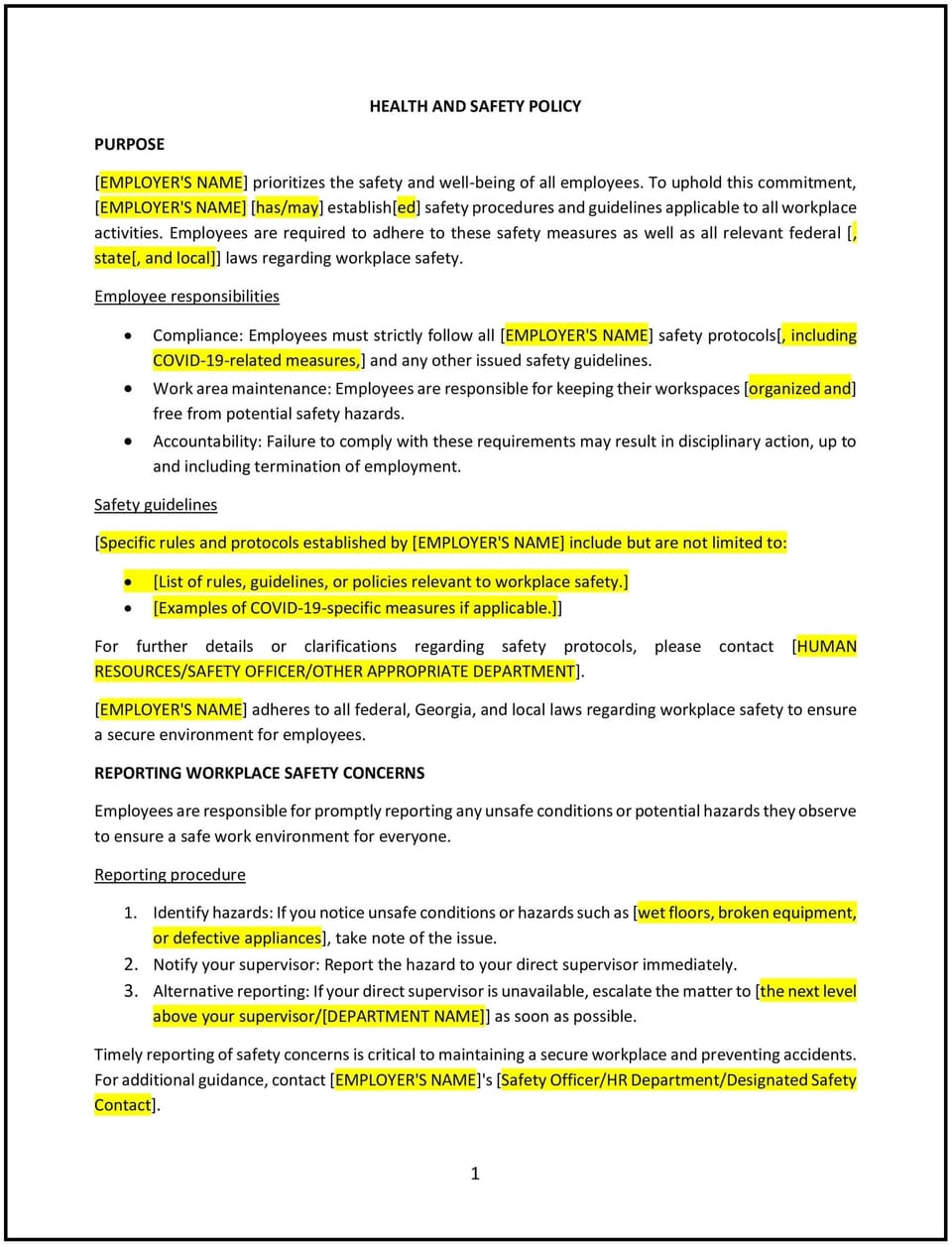Health and safety policy (Georgia): Free template

Health and safety policy (Georgia)
This health and safety policy is designed to help Georgia businesses create a safe and healthy work environment by outlining responsibilities, procedures, and guidelines for minimizing risks and protecting employees. The policy emphasizes proactive measures to prevent accidents and promote well-being in the workplace.
By implementing this policy, businesses can safeguard their workforce, enhance productivity, and demonstrate a commitment to employee welfare.
How to use this health and safety policy (Georgia)
- Define responsibilities: Clearly outline the roles of management, supervisors, and employees in maintaining workplace health and safety.
- Identify potential hazards: Conduct regular assessments to identify and mitigate risks specific to your workplace, such as ergonomic issues, hazardous materials, or equipment safety.
- Provide safety training: Offer regular training sessions to ensure employees understand safety protocols, emergency procedures, and how to report hazards.
- Develop emergency procedures: Create clear protocols for responding to emergencies such as fires, medical incidents, or natural disasters, tailored to Georgia’s risks.
- Implement reporting systems: Establish a system for employees to report accidents, near-misses, or unsafe conditions promptly and without fear of retaliation.
- Maintain safety equipment: Ensure all necessary safety equipment, such as fire extinguishers, first aid kits, and personal protective gear, is available and regularly inspected.
- Communicate the policy: Share the policy with employees during onboarding and provide updates as needed to maintain awareness.
- Review and update regularly: Periodically reassess the policy to reflect changes in Georgia laws, workplace conditions, or industry standards.
Benefits of using this health and safety policy (Georgia)
Implementing this policy provides several advantages for Georgia businesses:
- Reduces workplace incidents: Proactive safety measures minimize accidents and injuries.
- Boosts employee confidence: A focus on health and safety creates a secure and supportive work environment.
- Enhances productivity: Healthy and safe employees are more engaged and efficient in their roles.
- Improves regulatory readiness: Clear procedures and training prepare businesses for inspections or audits.
- Reflects Georgia-specific needs: Tailoring the policy to local risks, such as extreme weather or industry-specific hazards, ensures effectiveness.
Tips for using this health and safety policy (Georgia)
- Engage employees: Involve employees in identifying hazards and suggesting improvements to safety practices.
- Conduct regular inspections: Perform routine checks to ensure workplace conditions align with safety standards.
- Provide accessible training: Offer training in formats that accommodate different learning styles and languages.
- Monitor safety performance: Track incidents, near-misses, and employee feedback to identify trends and areas for improvement.
- Collaborate locally: Partner with Georgia-based safety organizations or resources to enhance your workplace safety initiatives.
Q: What should businesses include in emergency procedures?
A: Emergency procedures should cover evacuation routes, communication protocols, and roles for handling specific incidents, such as medical emergencies or fires.
Q: How can businesses ensure employees follow safety protocols?
A: Businesses should provide clear training, monitor adherence to protocols, and enforce disciplinary actions if necessary to maintain a safe environment.
Q: What are examples of safety equipment businesses should provide?
A: Examples include fire extinguishers, first aid kits, personal protective gear, and ergonomic furniture for desk-based roles.
Q: How should hazards be reported?
A: Employees should report hazards to their supervisor or HR using the designated reporting system, which should be accessible and confidential.
Q: What steps can businesses take to minimize hazards?
A: Businesses should conduct regular risk assessments, provide safety training, and ensure proper maintenance of equipment and facilities.
Q: How often should safety training be conducted?
A: Training should be conducted during onboarding, whenever new equipment or procedures are introduced, and at least annually for ongoing awareness.
Q: How often should this policy be reviewed?
A: The policy should be reviewed annually or as needed to reflect changes in Georgia laws, workplace conditions, or industry standards.
This article contains general legal information and does not contain legal advice. Cobrief is not a law firm or a substitute for an attorney or law firm. The law is complex and changes often. For legal advice, please ask a lawyer.


